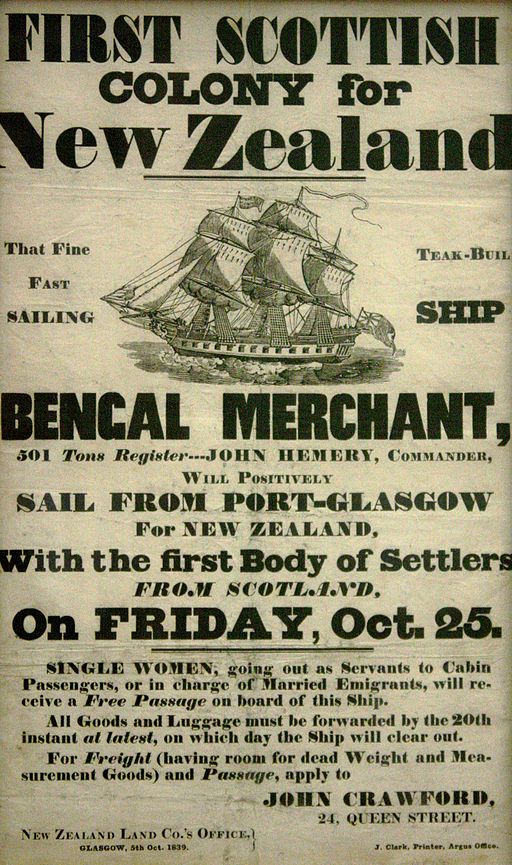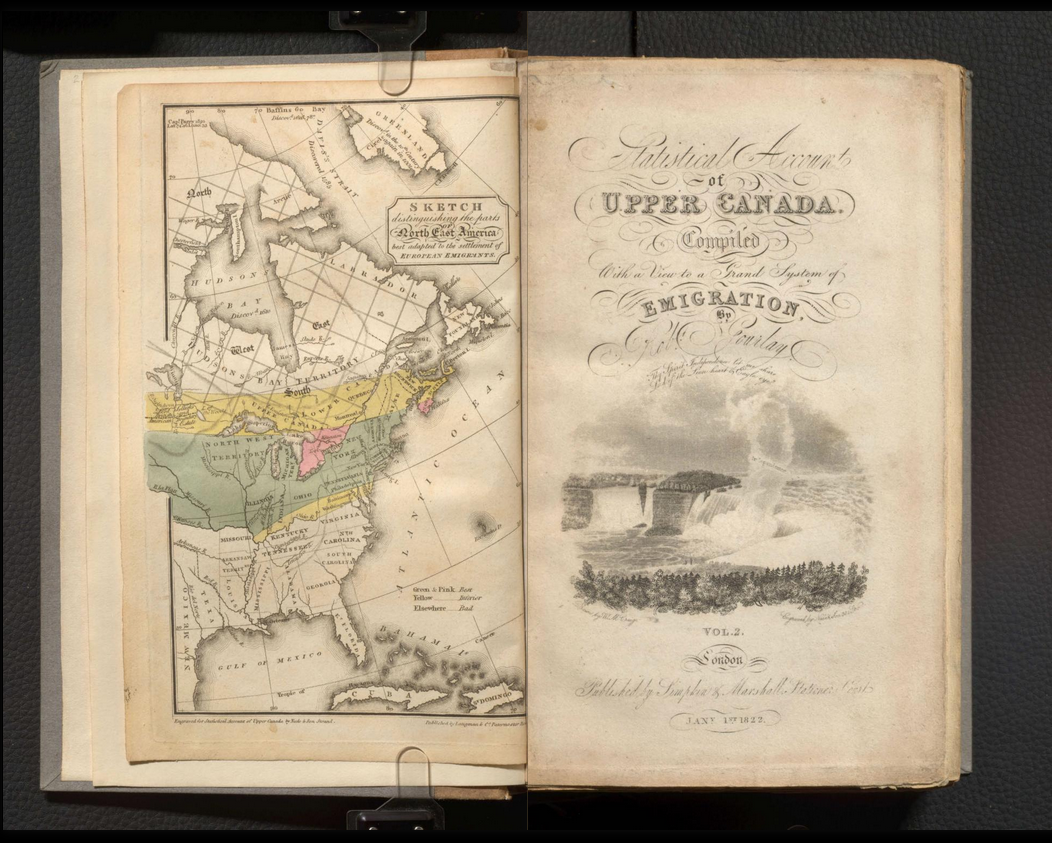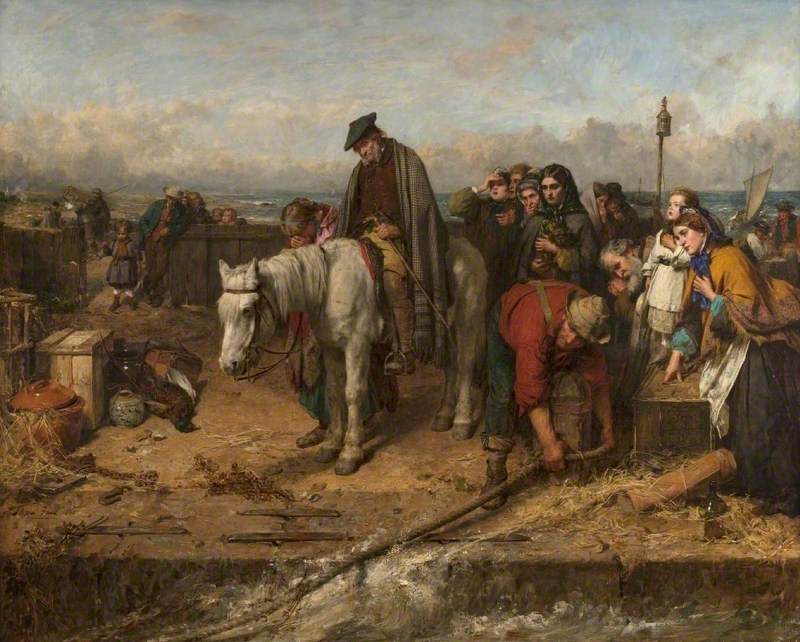The ‘Old’ and ‘New’ Statistical Accounts of Scotland are a record of what life was like in the parishes throughout Scotland, but reading through them you can see that it is not a country in isolation. During the 18th and 19th centuries Scotland had a wider place in the world, whether it was through emigration, travel or trade. The Scots and their way of life diffused into other parts of the world, most notably North America and Canada. Interaction through trade with other counties, such as India and England, is particularly emblematic of the influence nations had on each other, with the sharing of not just goods and services, but also ideas and experience.
In the first of two blog posts looking at the influence of Scotland in the world, we focus on Scottish emigration, its reasons and effects.
Emigration
In both Statistical Accounts there are many references to working-class Scots, often whole families, moving to other countries. The most common destination was North America and Upper Canada, though some did also emigrate to Australia and New Zealand.

Scottish Poster Advertising Emigration to New Zealand. By New Zealand Colony’s Office, Glasgow, 1839. [Public domain], via Wikimedia Commons.
“The increase since 1821… is considerably less than it would have been, owing to the extent to which emigration has been carried on during the last few years;-the average number of persons who have left this parish for the Canadas, during that period, being not much below twenty, annually. A considerable number also of young men leave this parish yearly, in quest of employment in the south.” (NSA, Vol. XIV, 1845, p. 222)
and in Ardnamurchan, County of Argyle:
“Families, numbering, 124 individual members, emigrated to America in 1790 and 1791. Since then, individuals and single families have been constantly emigrating to the low country or the colonies. In 1837 and 1838 not less than twenty families left Ardnamurchan and Sunart chiefly for Australia. About five years ago, thirteen families, amounting to about 70 individuals, emigrated to Canada. In 1837 and 1838, families, amounting to about 100 individuals, sailed for Australia.” (NSA, Vol. VII, 1845, p. 148-149)
The reasons for emigration
By far the biggest reason for such a high level of Scottish emigration is the Highland Clearances, which took place in the Scottish Highlands during the eighteenth and nineteenth centuries. In The Statistical Accounts there is specific mention of changes in agricultural practices (the Scottish Agricultural Revolution), overpopulation (which caused increased burden on an already undeveloped infrastructure), and landlords debts (which resulted in their demand for higher rents).
In Tiree and Coll, County of Argyle, “Thirty-six men, women, and children, emigrated from Coll to America in 1792. None hitherto has emigrated from Tiree, though some talk of doing so. Their crops failed in 1790 and 1791, which, together with the low prices of kelp and cattle, has much reduced them. They must soon go somewhere for relief, unless manufactures be introduced to employ them.” (OSA, Vol. X, 1794, p. 416)
In the first half of the nineteenth century, landowners, such as Sir W.D. Stewart in the district of Little Dunkeld, County of Perth, were now converting their small farms into large ones. “The consequence is, that many of the small tenants are turned out of their possessions, to shift for themselves and families the best way they can. Some of them have sought farms in other parishes, and some have emigrated to Canada, never again expecting to return to the land of their nativity, and of their early associations.” (NSA, Vol. X, 1845, p. 1011)
It seems that even inhabitants in districts not affected by this change in farming, such as Moneydie in the County of Perth, were still emigrating, probably knowing that it was only a matter of time before the changes would reach their parish, or they just felt that their life would be better somewhere else.
“In Logiealmond, where the system of large farms has not yet been adopted, and where the population is large in proportion to the soil, any decrease that has taken place has been in consequence of emigration. – Within the last eight years, upwards of 100 persons have emigrated to Canada from Logiealmond alone.” (NSA, Vol. X, 1845, p. 202)
A particularly insightful assessment on emigration at the end of the eighteenth century (including thoughts on how “to put a stop to the present rage for emigration”) can be found in the parish report for North Uist, County of Inverness (OSA, Vol. XIII, 1794, p. 317-320).
“The sense of grievances, whether real or imaginary; the fear of having the fruits of their industry called for by their landlords, many of whom think they have a right to the earnings of the tenants, except what barely supports life; the want of employment for such as have no lands to cultivate; the encouragements held out to them by their friends, who are already settled in that country, of living in a state of much greater affluence with less labour; and the facility of procuring a property for a small sum of money, the produce of which they can call their own, and from which their removal does not depend on the will of capricious masters. These are the principal motives that determine people now to emigrate to America, without at all attending to the difficulties and discouragements in their way…”
Such difficulties were very apparent in 1834 when thousands of emigrants fell victim to cholera soon after landing in Canada, as reported by the parish of Bedrule, County of Roxburgh (NSA, Vol. III, 1845, p. 296-297). Other dangers included the sea crossing itself, traveling many miles from the shore to reach the settlements, buying necessities anew and the possibly disagreeable effects of the new climate on their health (OSA, Vol. XIII, 1794, p. 317-320)
Role of Scottish Land-Owners
It is very interesting to read in The Statistical Accounts about the role Scottish landlords had on the emigration of the poor and working classes. Some actively helped their tenants to emigrate, such as Lord MacDonald in the parish of Portree, County of Inverness, “expended large sums of money in conveying the poor people, on his property (tenants or not tenants) to North America” (NSA, Vol. XIV, 1845, p. 231). Others tried to prevent it, such as Mr. Dale, a landowner in Lanark, who offered employment, housing and schooling to families who were trying to emigrate to America but were caught up in a storm (OSA, Vol. XV, 1795, p. 40). He also showed some ingenuity by letting people living in Argyleshire and the isles know that they could come and work for him (which many did)! It is very likely that acts like these were not completely borne out of concern for the Scottish working class, but also showed an evident desire towards self-advancement.
It was not only the land-owners who helped people emigrate. In the parish of Whitsome and Hilton, County of Berwick, L.8 out of its L. 115, 19s total of poor and parochial funds (year ending at Martinmas 1833) was spent on enabling a pauper to emigrate to Canada! (NSA, Vol. II, 1845, p. 179)
Effect of Emigration on Scotland
The depopulation of Scotland was of particular concern to many. The Rev. Mr. James Robertson, Minister of the parish of Callander, County of Perth, called emigration a”national evil” that “must be stopped, either by legal restraints, or by sound policy”.
“When we have battles to fight in any future wars, our hardy peasantry, who are the strength of a country, may be gone and we shall have none to recruit our armies, except a band of mercenaries from abroad, (who may turn their swords against ourselves), and effeminate manufactures, or defenseless sheep and shepherds dogs.” (OSA, Vol. XI, 1794, p. 626)
Other negative aspects of emigration in Scotland are mentioned in the parish report for Elgin, County of Elgin, including the increase in manufacturing (which causes ill health), loss of sheep farmers and even acts as a deterrent to marriage! (OSA, Vol. V, 1793, p. 20)
As the Reverend Mr Roderick Macrae, Missionary Minister in the parish of Applecross, wrote in the report for Lochbroom Parish, County of Ross and Cromarty:
“It has been said, however, that these people who are dispossessed of their farms, can live much more comfortably in the manufacturing employment, than ever they could do before.
But would they not be still more happy, if manufactures were introduced among themselves*? And is it not a matter of importance to the nation to encourage population in the High-
lands, as well as in other parts of the kingdom?” (*There was a LINT MANUFACTURING STATION established here, some time ago…) (OSA, Vol. X, 1794, p. 471)
Influence of emigration
- Religion
A large area of influence which Sottish emigration had on countries abroad was in the realm of religion. It was considered very important for emigrants to practice the right religion correctly. The Rev. James Russell, a minister at the Presbytery of Lochcarron, Parish of Gairloch in the County of Ross and Cromarty, wrote in September 1836:
“The population is by much too dense for the means of support which they enjoy. A Government grant to convey one-third of the people to Upper Canada would be most desirable; and, in order to promote the moral and religious improvement of the people, two missionaries, and from six to eight schools, on a proper footing, are absolutely necessary and loudly called for.” (NSA, Vol. XIV, 1845, p. 99)
In Weem, County of Perth, a Bible Society had been established and great satisfaction arose “that many of our emigrated countrymen are now in possession of Bibles purchased here, several of them in the back-woods of Canada, and a few on the shores of Australia.” (NSA, Vol. X, 1845, p. 714)
There is also mention in the report for Kincardine, County of Ross and Cromarty, of a “Gaelic and English congregation at Dundas in Upper Canada (now Aldborough, presbytery of Toronto;)” (NSA, Vol. XIV, 1845, p. 431).
Emigration also had an effect on religion at home. As many of Scotland’s best laborers re-located from the North Highlands to America, many Glasgow manufacturers encouraged hard-working Roman Catholics to work for them, promising them security in the exercise of their religion. (NSA, Vol. VI, 1845, p. 194)
- Surveys and diffusion of information
Another big area of influence was on the surveying of Canada and the way of life of its inhabitants. The Scot Robert Fleming Gourlay (1778-1863) first emigrated to Canada in 1817 and, while there, compiled two volumes of the Statistical Account of Upper Canada, using the Statistical Accounts of Scotland model developed by Sir John Sinclair. (Both Volume 1 and Volume 2 can be found on the Internet Archive.) Even though there are deficiencies, it is considered “easily the best compendium of information about Upper Canada for his period. Though Gourlay made no attempt to analyze them, the 57 township reports he printed present an unrivaled picture of provincial social and economic life”. (Dictionary of Canadian Biography) Gourlay’s story is fascinating and is well worth reading.

The Statistical Account of Upper Canada : compiled with a view to a grand system of emigration, Vol. 2, 1822. Found on the Internet Archive.
Another Scot who surveyed and reported on Canada was Roderick Mackenzie (c.1761-1844) who emigrated to Canada in 1784 to work in the fur trade. He wrote the Survey of North West Canada, which was issued as a printed circular to the Indian traders in the North West Company from Montreal on 21 April 1806. This and the subsequent responses by the other traders, can be found on the scholarly research website In Pursuit of Adventure: The Fur Trade in Canada and the North West Company. He took direct influence from Sir John Sinclair, having seen the strong similarities between the accounts given by the Parish clergy and those that might be obtained from the traders of the seven Indian tribes.
Interestingly, in the Statistical Accounts there is also mention of a Mr. Calder in the parish report of Whitsome and Hilton, County of Berwick, who was the “author of a very neat account of the Five Nations of Canada” (OSA, Vol. XVI, 1795, p. 355). The Five Nations of Canada refers to the Iroquois, a historically powerful northeast Native American confederacy, pre-1722.
As well as surveying, Scots played a part in making information easily available. Libraries were set up in Canada, among other countries, through Samuel Brown, Esq.’s initiative of itinerating (or traveling) libraries, which began in 1817 and whose headquarters was at Haddington. This involved collections of books (divisions) being “stationed in the towns and villages of the county for two years, when they are removed and exchanged.”
“In 1831 and 1834, I received from a few friends of the plan about L.400, to promote the introduction of libraries into certain specified districts, and I have since sent to various parts of Scotland, England, Ireland, Jamaica, Canada, South Africa, St Petersburgh, ninety divisions containing 4500 volumes. They were furnished at cost prices, and to same districts at half the cost price, and those sent to Ireland still lower. They were placed under the superintendence of gentlemen or ladies in the different districts.” (OSA, Vol. II, 1845, p. 17)
For further information take a look at the book Some Account of Itinerating Libraries and Their Founder by Samuel Brown which is available on the Internet Archive.
In the next blog post on the influence of Scotland on the world, we will focus on trade with other counties and Scots working abroad.


